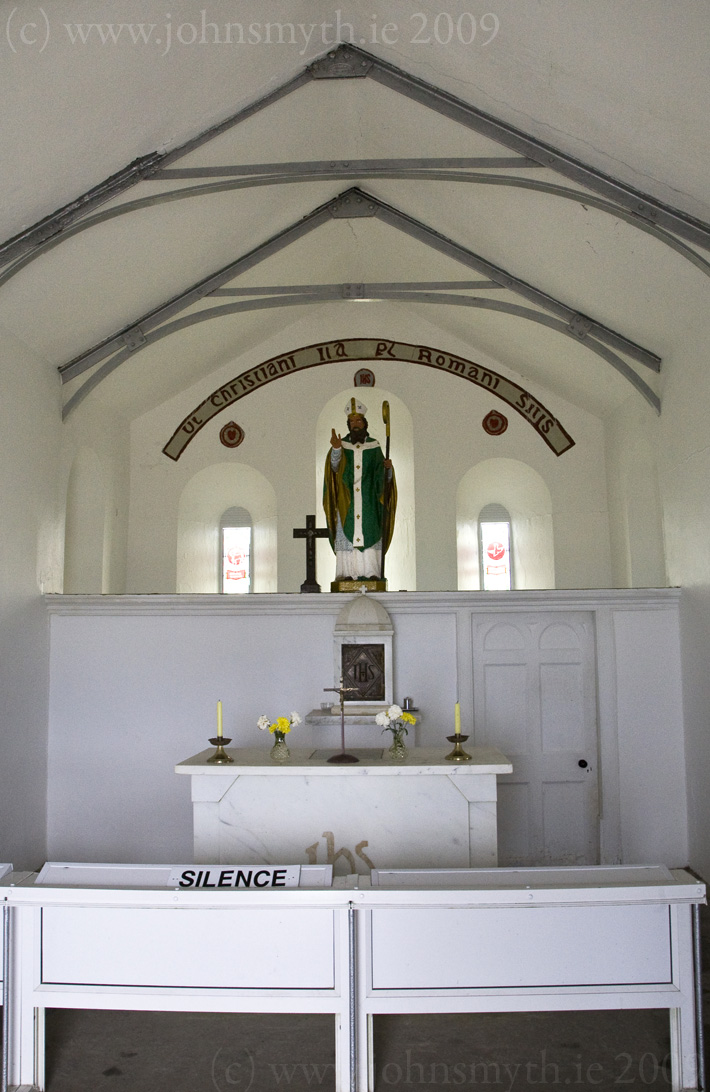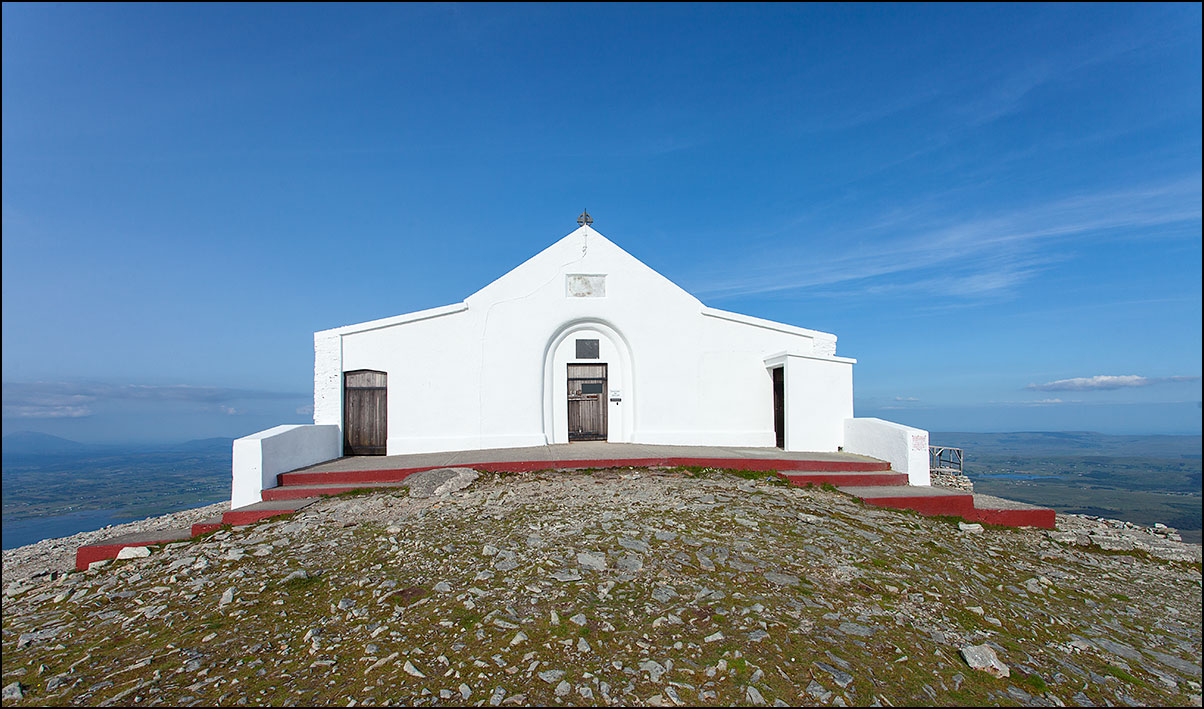By Brian Lacey.
The 17 March is St Patrick’s Day. St Patrick is honoured as the patron saint of Ireland (although in medieval times there were two other patrons: Saint Brigid and Saint Colum Cille). His feastday is celebrated also in many other parts of the world, especially in countries such as the USA where the Irish have settled in great numbers. The 17 March is the day he is believed to have died. Saints’ feastdays usually occur on the day that they died. Since the second century AD the anniversary of a saint’s death has been commemorated not as a day of mourning but as a ‘feast day’, in Latin the dies natalis or the saints ‘second’ birthday, the day they were reborn into the next life – into heaven.
Croagh Patrick Mountain
Although he is frequently linked with Irish nationalism, paradoxically Patrick was actually British – the traditional enemies of the Irish. He was probably born at the end of 4th century in Britain which was still under Roman rule at the time. Christianity had been the official religion of the Empire for most of that century. Patrick’s grandfather was a Christian priest (possibly even a bishop) and his father a church deacon as well as being a minor Roman official, probably a tax-collector. Unlike Britain, Ireland had never been conquered by the Romans and was outside the Empire although there were, of course, trading and other connections.
The Annual Croagh Patrick Climb. Foto: Irish Mirror
Patrick was kidnapped by Irish Celtic raiders when he was about sixteen years old and spent six years in Ireland as a slave herding animals. Although nominally Christian since his childhood, he underwent a profound religious conversion during his captivity. Although he eventually escaped and got back to his homeland when he was about twenty-two years of age, he experienced a desire (‘dreams’ and ‘visions’) to go back to Ireland to convert its pagan inhabitants to Christianity.
We know all this from two letters that he wrote. In fact, in a technological sense, apart from his religious achievements, Patrick’s greatest contribution to Irish culture was that he brought the skills of reading and writing to the island. Christianity is a religion of a book – the Bible. Christianity – although not necessarily for all its members – is not possible without the allied skills of reading and writing. Those who study the past distinguish between the ‘historic’ and the ‘prehistoric’ periods. The ‘historic’ is the time from which we have written material which enables us to reconstruct ‘history’. St Patrick, as one modern historian called him, is the ‘portal’ into Irish history. Other than some basic stone carvings in a script known as Ogam, Patrick’s two letters are the oldest written material from Ireland that still survive.
Croagh Patrick Church. Foto: John Smyth
The 17 March is now the occasion of festivities all over the world that are not always particularly Christian. St Patrick is thought of as almost a brand-name, recognised and celebrated in many places that have no particular connection with Ireland or with the Christian religion. But the medieval records about him are quite confused, to the point that it was often said in the past that there must have been at least two St Patricks! In Ireland until recent decades, St Patrick’s Day was marked mainly as a quiet religious occasion. The flamboyant festival nowadays associated with the saint is largely a modern export from the USA. St Patrick’s Day parades originated mainly among Protestant Irish units of the British Army in America in the 18th century, although they were increasingly taken over by Catholic Irish emigrant institutions in the 19th century.
Croagh Patrick Church. Foto: John Finn
All this is a far cry from the humbleness of Patrick himself. Like all medieval saints, Patrick’s genuine story was expanded and inflated for both religious and secular political purposes from shortly after the time of his death. But we can strip back a lot of the later accumulations of propaganda to reveal a truly historic and heroic individual who is not tied to any modern political or religious tradition but belongs to all the people of Ireland and, increasingly, to people of different religions and none in many other parts of the world.
St. Patrick Statue. Foto: Didrik Johnck
However, two of the best known legends about Patrick are definitely not historically true. He is said to have driven the snakes out of Ireland. Snakes were used in medieval literature as a metaphor for the devil and evil. But there never were any snakes in Ireland – they simply never reached the island naturally after the last Ice Age. Patrick is also linked with the shamrock, a tiny three-leaved plant belonging to the clover family, which has been used in modern times as a symbol of Ireland. Legend – not dating any earlier than about 1700 – claims that Patrick used the shamrock to explain the Christian mystery of the Holy Trinity – three leaves but one plant! But, as we know from ancient literature and from sculptures dating from the Iron Age, the Irish already believed in three-person gods and goddesses long before Christianity arrived on the island.
Autor del texto: Brian Lacey
Montaña sagrada de Croagh Patrick. Foto:animekiller
El 17 de marzo es el Día de San Patricio. San Patricio es honrado como el santo patrón de Irlanda (aunque en la época medieval también lo eran Santa Brígida y San Columba, Colum Cille en gaélico). Su festividad se celebra en muchas otras partes del mundo, especialmente en países como los EE.UU, donde los irlandeses se han asentado en gran número. El 17 de marzo es el día en el que se cree que murió. Los días festivos de los santos generalmente corresponden al día en que murieron. Desde el siglo II de nuestra el aniversario de la muerte de un santo se ha conmemorado no como un día de luto, sino como un «día de fiesta», en latín dies natalis o ‘segundo’ de cumpleaños de los santos, el día en que renacieron en la otra vida, en el cielo.
Croagh Patrick
A pesar de que está a menudo relacionado con el nacionalismo irlandés, paradójicamente Patricio era en realidad británico, los enemigos tradicionales de los irlandeses. Probablemente nació a finales del siglo IV en Gran Bretaña que aún estaba bajo el dominio romano en aquel momento. El cristianismo había sido la religión oficial del Imperio durante la mayor parte de este siglo. El abuelo de Patricio era un sacerdote cristiano (posiblemente incluso un obispo) y su padre un diácono de la iglesia, además de ser un oficial romano menor, probablemente un recaudador de impuestos. A diferencia de Gran Bretaña, Irlanda nunca había sido conquistada por los romanos y no formaba parte del Imperio, aunque existía, por supuesto, el comercio y otras conexiones.
Peregrinación anual a Croagh Patrick
Patricio fue secuestrado por los invasores celtas irlandeses cuando tenía unos dieciséis años y pasó seis años en Irlanda como esclavo dedicado al cuidado del ganado. Aunque era cristiano desde su infancia, fue sometido a una profunda conversión religiosa durante su cautiverio. Aunque finalmente se escapó y regresó a su tierra natal. Cuando tenía unos veintidós años de edad experimentó un deseo («sueños» y «visiones») de regresar a Irlanda para convertir sus habitantes paganos al cristianismo.
Estatua de San Patricio en Croagh Patrick
Sabemos todo esto a partir de dos cartas que escribió. De hecho, en un sentido técnico, además de sus logros religiosos, la mayor contribución de Patricio a la cultura irlandesa fue que él trajo las habilidades de lectura y escritura a la isla. El cristianismo es una religión de un libro,la Biblia. El Cristianismo, aunque no necesariamente para todos sus miembros, no es posible sin las habilidades aliadas de la lectura y la escritura. Los que estudian el pasado distinguen entre Prehistoria y períodos históricos. La Historia es el tiempo del que disponemos de un material que nos permite reconstruir la Historia escrita. San Patricio, como algún historiador moderno le ha definido, es el «portal» o punto de partida en la historia de Irlanda. Aparte de algunas inscripciones en piedra en un guión conocido como Ogam, dos cartas de Patricio son el material escrito más antiguo de Irlanda, que aún sobreviven.
Interior de la Iglesia de San Patricio. Foto: John Smyth
El 17 de marzo es ahora motivo de festividades en todo el mundo que no siempre son particularmente cristianas. Se piensa en San Patricio casi como en una marca, que se reconoce y se celebra en muchos lugares que no tienen una conexión particular con Irlanda o con la religión cristiana. Pero los registros medievales sobre él son bastante confusos, hasta el punto que se ha dicho a menudo en el pasado que tiene que haber habido al menos dos St Patricios! En Irlanda hasta las últimas décadas, el Día de San Patricio se caracterizó principalmente como una ocasión religiosa tranquila. El festival extravagante hoy asociado con el santo es en gran parte un producto de exportación moderna de los EE.UU. Los desfiles del Día de San Patricio se originaron principalmente entre unidades irlandeses protestantes del Ejército británico en América en el siglo XVIII, a pesar de que se hicieron cada vez más populares entre las instituciones de emigrantes irlandeses católicos en el siglo XIX.
Iglesia de san Patricio en Croagh Patrick. Foto: John Finn
Todo esto está muy lejos de la humildad del mismo Patricio. Como todos los santos medievales, la historia genuina de Patricio se amplió y se infla tanto para fines políticos religiosos y seculares desde poco después de la hora de su muerte. Pero podemos prescindir de muchas de las acumulaciones posteriores de propaganda para revelar un individuo verdaderamente histórico y heroico que no estuvo vinculado a ninguna tradición política o religiosa moderna, sino que pertenece a todo el pueblo de Irlanda y, cada vez, a las personas de diferentes religiones y en muchas otras partes del mundo.
Estatua de San Patricio. Foto: Didrik Johnck
Sin embargo, dos de las leyendas más conocidas sobre Patricio definitivamente no son históricamente ciertas. Se dice que expulsó a las serpientes de Irlanda. Las serpientes fueron utilizados en la literatura medieval como una metáfora para el diablo y el mal. Pero nunca hubo serpientes en Irlanda, simplemente nunca llegaron a la isla de forma natural después de la última Edad de Hielo. Patricio también está vinculado con el trébol, una pequeña planta de tres hojas que pertenece a esta familia de plantas, que se ha utilizado en los tiempos modernos como un símbolo de Irlanda. La leyenda no parece ser más antigua que alrededor de 1700, afirma que Patricio utilizó el trébol para explicar el misterio cristiano de la Santísima Trinidad, ¡tres hojas pero una sola planta!. Pero, como sabemos por la literatura antigua y las esculturas que datan de la Edad de Hierro, los irlandeses ya creían en los dioses de tres personas y diosas mucho antes de que el cristianismo llegara la isla.
































Deje su comentario